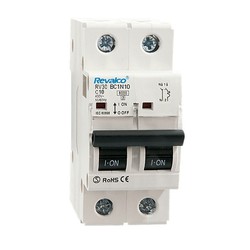IGA 4P 63A - Protection against three-phase Permanent + Transient overvoltages
Brand: REVALCO
Reference: IGA10PT4P63EN
Offer: £137.30
PVP: £565.11
Product sold out, not available at this time.
Next stock entry on the way, expected
Description
Protection against three-phase Permanent + Transient overvoltages with mechanical/luminous status indication with dimensions of 7.5 modules (135mm), intensity Imax: 40KA, manual reset and the possibility of making it Auto-Reset. According to EN50550/IEC61643-1 regulations
Features
- Number of modules:
- 8
Details
More information
The equipment measures the voltage in the installation permanently and detects any increase in it, or loss of neutral. In case of detecting said anomaly, it acts on the IGA (Automatic General Switch), disconnecting the voltage in the installation. The action time will depend on the level of overvoltage detected (according to the specifications of the EN50550 Standard).
The device will be operational again once it is manually reset, as long as the voltage is within its nominal values.
In the event that a transient overvoltage occurs, the equipment absorbs it, thus preventing it from causing any damage to the devices connected to the network (according to the specifications of the IEC61643-1 Standard).
Yes due to a transient overvoltage the protection will be inoperative, the module on the right will show the warning light in red. In this case, the protective module will have been rendered useless.
Main characteristics of the IGA 4P 63A - Three-phase protection against permanent + transitory overvoltages
- Protection device against permanent overvoltages caused by increases in the network voltage, in three-phase installations.
- It also protects against transient overvoltages caused by atmospheric phenomena (class Type II).
- Formed by an automatic general switch (IGA) + Permanent overvoltage protector (SPD) and three-phase transients.
< br>Technical characteristics of the IGA 4P 63A - Protection against three-phase Permanent + Transient overvoltages
- Nominal voltage: 400 V
- Nominal frequency: 50 / 60Hz
- Maximum terminal section: 25mm2
- Compact easy to connect (7.5 DIN modules / 134mm)
- Dimensions (width x height x depth) mm: 134 x 90 x 71
- Protection: IP20
- IGA rated current: 63A
- IGA Curve: C
- Breaking power: 10 KA
- Intensity Imax: 40 KA
- Manual Reset
- Accessory (tripping coil and auxiliary contact)
- Possibility of making it Auto-Reset
- Remote control through an accessory of 1 or 2 modules
- Luminous indication of transient protection status:
Red: SPD fault status.
Green: SPD normal status.
The device will be operational again once it is manually reset, as long as the voltage is within its nominal values.
In the event that a transient overvoltage occurs, the equipment absorbs it, thus preventing it from causing any damage to the devices connected to the network (according to the specifications of the IEC61643-1 Standard).
Yes due to a transient overvoltage the protection will be inoperative, the module on the right will show the warning light in red. In this case, the protective module will have been rendered useless.
Main characteristics of the IGA 4P 63A - Three-phase protection against permanent + transitory overvoltages
- Protection device against permanent overvoltages caused by increases in the network voltage, in three-phase installations.
- It also protects against transient overvoltages caused by atmospheric phenomena (class Type II).
- Formed by an automatic general switch (IGA) + Permanent overvoltage protector (SPD) and three-phase transients.
< br>Technical characteristics of the IGA 4P 63A - Protection against three-phase Permanent + Transient overvoltages
- Nominal voltage: 400 V
- Nominal frequency: 50 / 60Hz
- Maximum terminal section: 25mm2
- Compact easy to connect (7.5 DIN modules / 134mm)
- Dimensions (width x height x depth) mm: 134 x 90 x 71
- Protection: IP20
- IGA rated current: 63A
- IGA Curve: C
- Breaking power: 10 KA
- Intensity Imax: 40 KA
- Manual Reset
- Accessory (tripping coil and auxiliary contact)
- Possibility of making it Auto-Reset
- Remote control through an accessory of 1 or 2 modules
- Luminous indication of transient protection status:
Red: SPD fault status.
Green: SPD normal status.
Comments
There are no opinions yet Be the first to review!
Questions
No questions yet Do you have any doubt?
Best price
Have you seen it cheaper?
Find more products in
Our customers trust us

4.55/5 (2237 votes)
















